TOYOTA 86 2017 Owners Manual
Manufacturer: TOYOTA, Model Year: 2017, Model line: 86, Model: TOYOTA 86 2017Pages: 428, PDF Size: 5.25 MB
Page 121 of 428
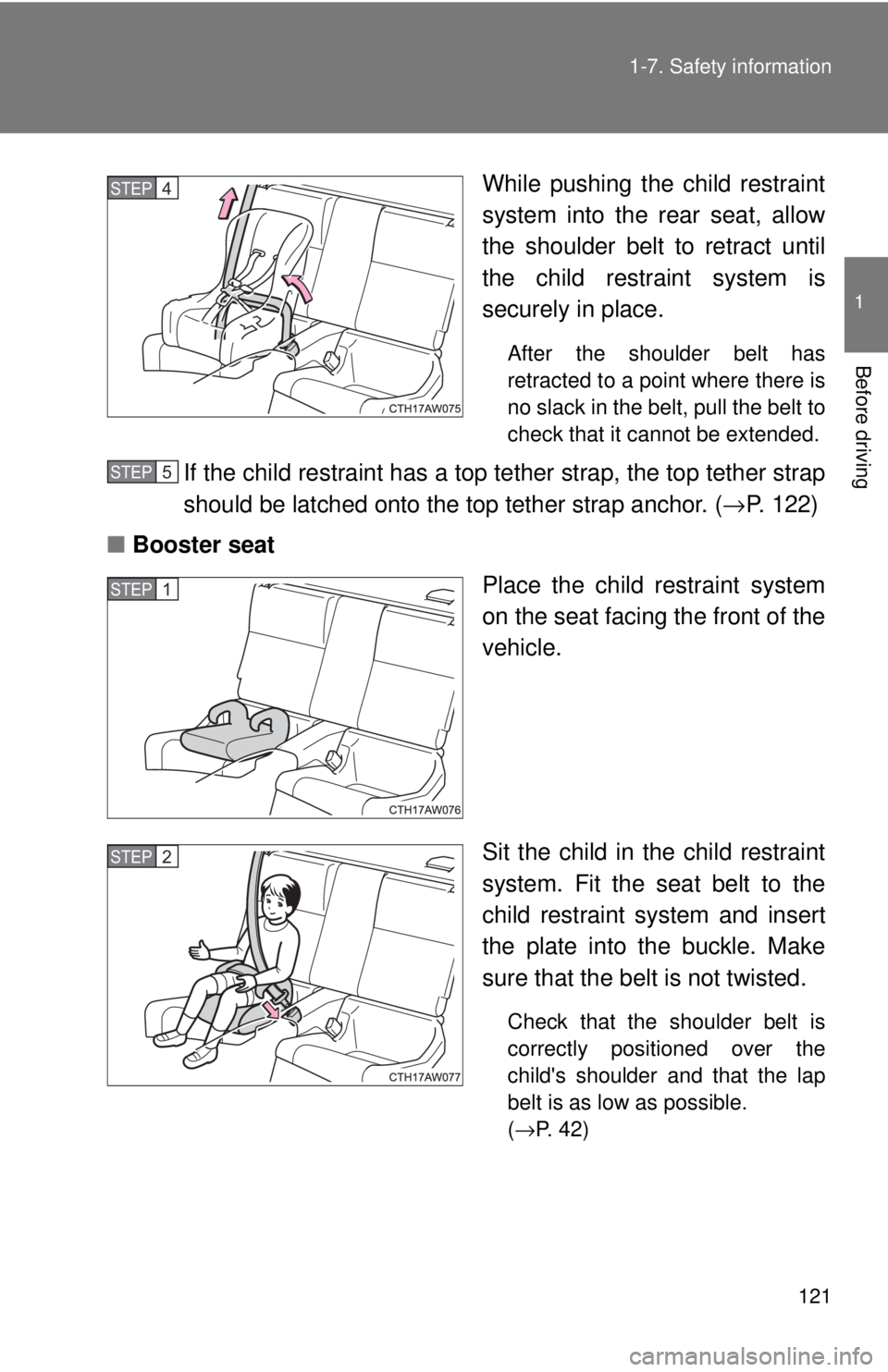
1211-7. Safety information
1
Before driving While pushing the child restraint
system into the rear seat, allow
the shoulder belt to retract until
the child restraint system is
securely in place. After the shoulder belt has
retracted to a point where there is
no slack in the belt, pull the belt to
check that it cannot be extended.
If the child restraint has a top te ther strap, the top tether strap
should be latched onto the top tether strap anchor. ( → P. 122)
■ Booster seat
Place the child restraint system
on the seat facing the front of the
vehicle.
Sit the child in th e child restraint
system. Fit the seat belt to the
child restraint system and insert
the plate into the buckle. Make
sure that the belt is not twisted.
Check that the shoulder belt is
correctly positioned over the
child's shoulder and that the lap
belt is as low as possible.
( → P. 42)STEP 4
STEP 5
STEP 1
STEP 2
Page 122 of 428
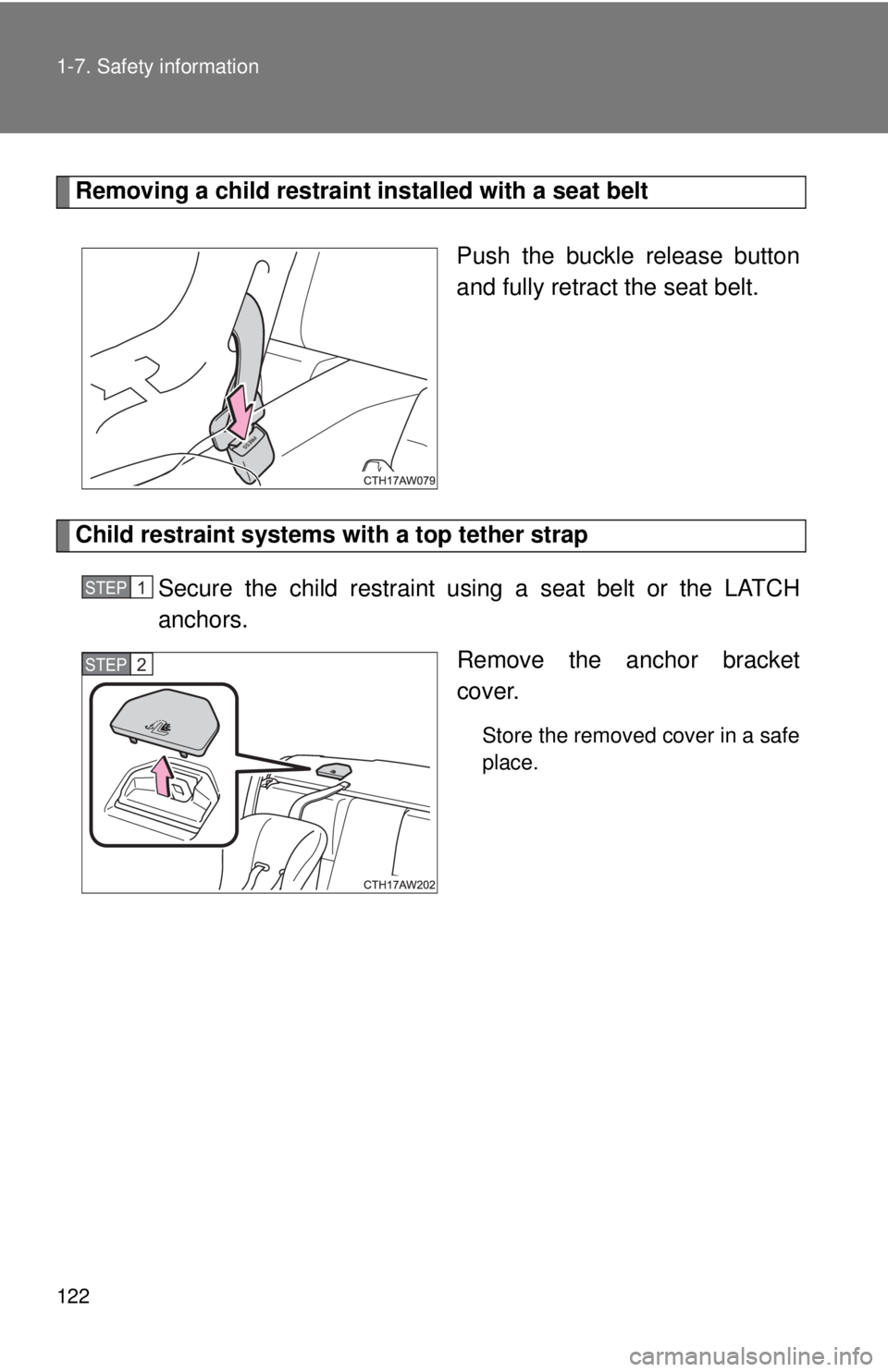
1221-7. Safety information
Removing a child restraint installed with a seat belt
Push the buckle release button
and fully retract the seat belt.
Child restraint systems with a top tether strap
Secure the child restraint using a seat belt or the LATCH
anchors.
Remove the anchor bracket
cover. Store the removed cover in a safe
place.STEP 1
STEP 2
Page 123 of 428
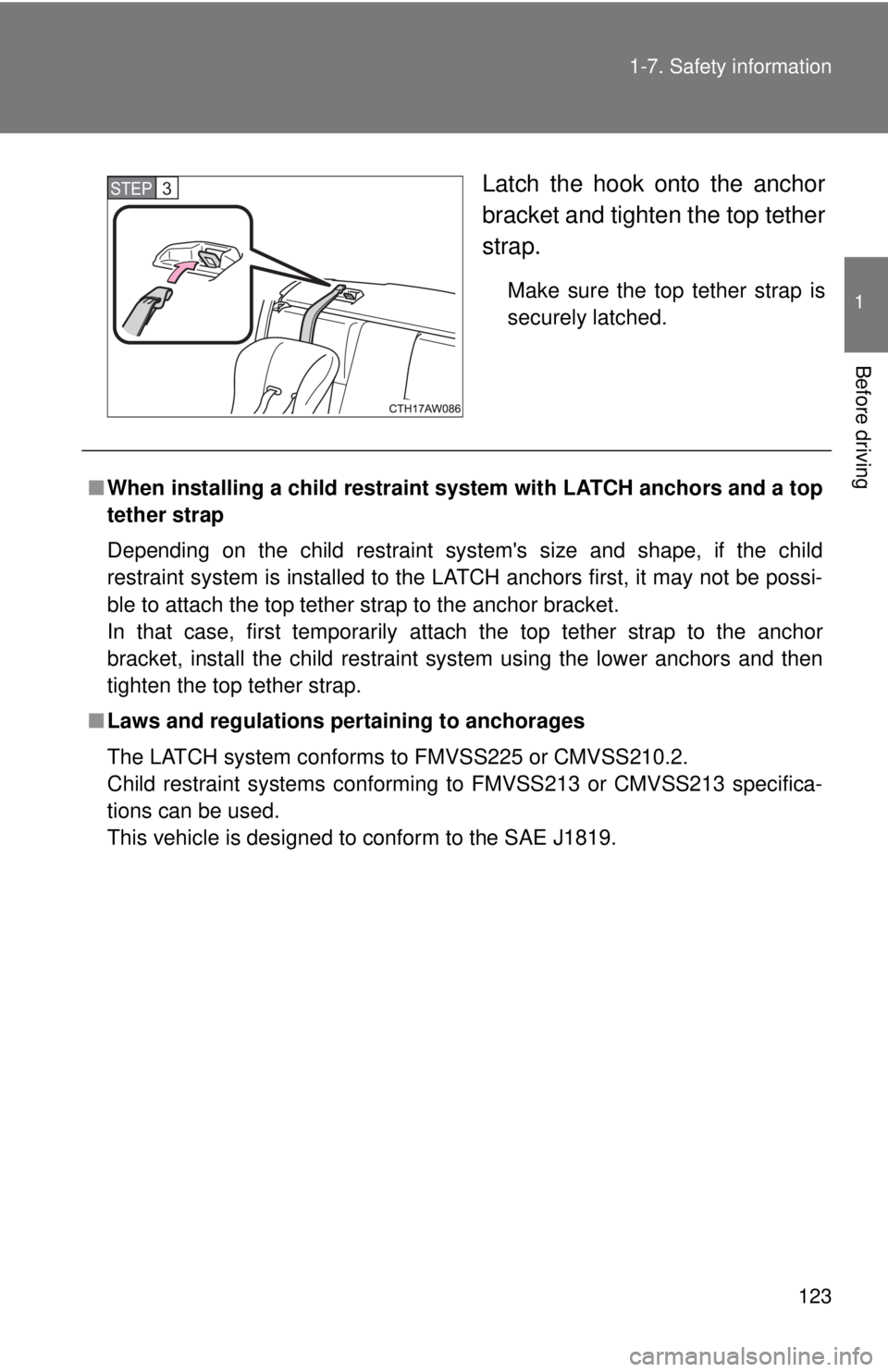
1231-7. Safety information
1
Before driving Latch the hook onto the anchor
bracket and tighten the top tether
strap. Make sure the top tether strap is
securely latched. STEP 3
■ When installing a child restraint system with LATCH anchors and a top
tether strap
Depending on the child restraint system's size and shape, if the child
restraint system is installed to the LATCH anchors first, it may not be possi-
ble to attach the top tether strap to the anchor bracket.
In that case, first temporarily attach the top tether strap to the anchor
bracket, install the child restraint system using the lower anchors and then
tighten the top tether strap.
■ Laws and regulations pertaining to anchorages
The LATCH system conforms to FMVSS225 or CMVSS210.2.
Child restraint systems conforming to FMVSS213 or CMVSS213 specifica-
tions can be used.
This vehicle is designed to conform to the SAE J1819.
Page 124 of 428
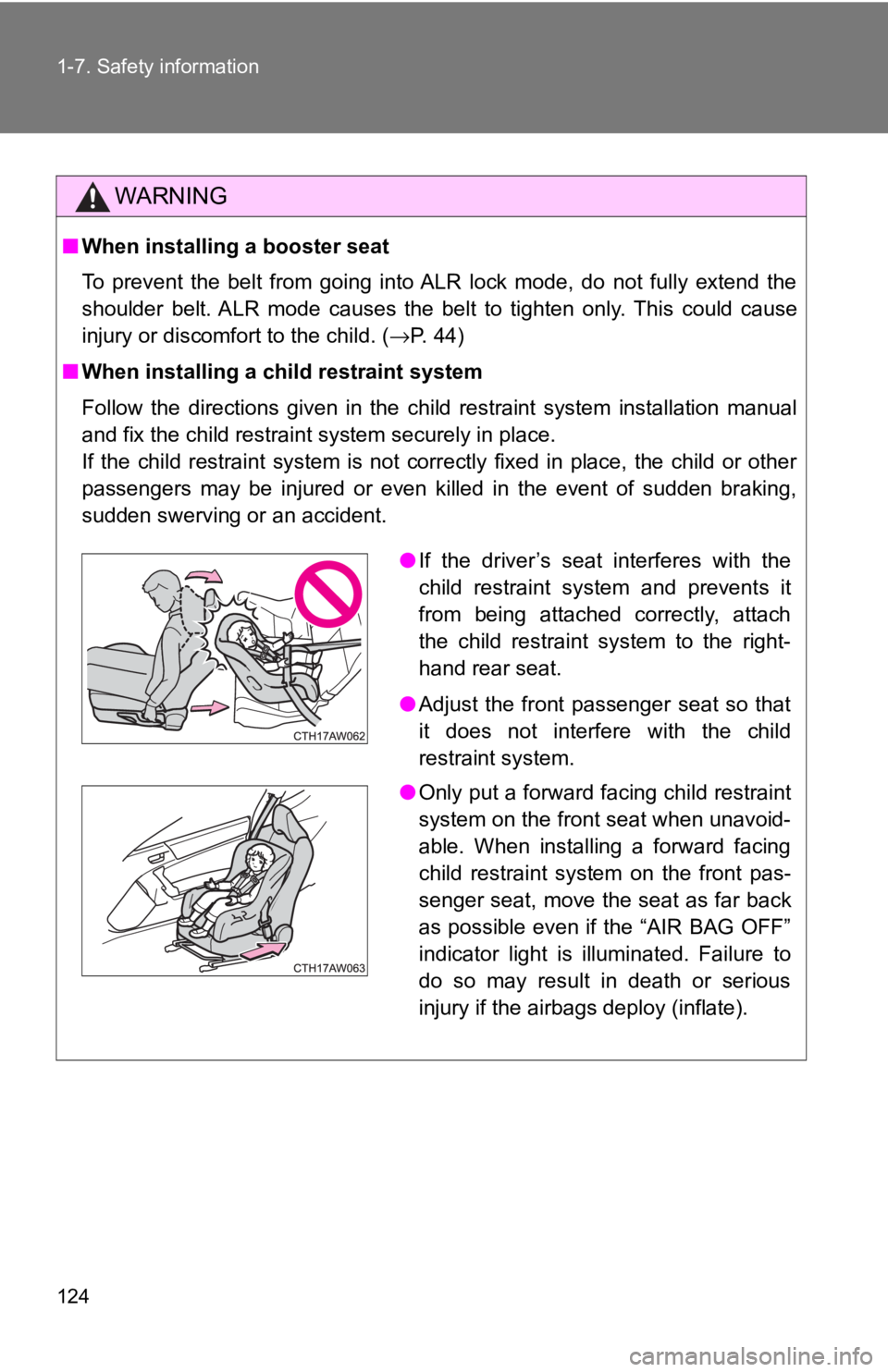
1241-7. Safety information
WARNING■ When installing a booster seat
To prevent the belt from going into ALR lock mode, do not fully extend the
shoulder belt. ALR mode causes the belt to tighten only. This could cause
injury or discomfort to the child. ( → P. 44)
■ When installing a child restraint system
Follow the directions given in the child restraint system installation manual
and fix the child restraint system securely in place.
If the child restraint system is not correctly fixed in place, the child or other
passengers may be injured or even killed in the event of sudden braking,
sudden swerving or an accident.
● If the driver’s seat interferes with the
child restraint system and prevents it
from being attached correctly, attach
the child restraint system to the right-
hand rear seat.
● Adjust the front passenger seat so that
it does not interfere with the child
restraint system.
● Only put a forward facing child restraint
system on the front seat when unavoid-
able. When installing a forward facing
child restraint system on the front pas-
senger seat, move the seat as far back
as possible even if the “AIR BAG OFF”
indicator light is illuminated. Failure to
do so may result in death or serious
injury if the airbags deploy (inflate).
Page 125 of 428
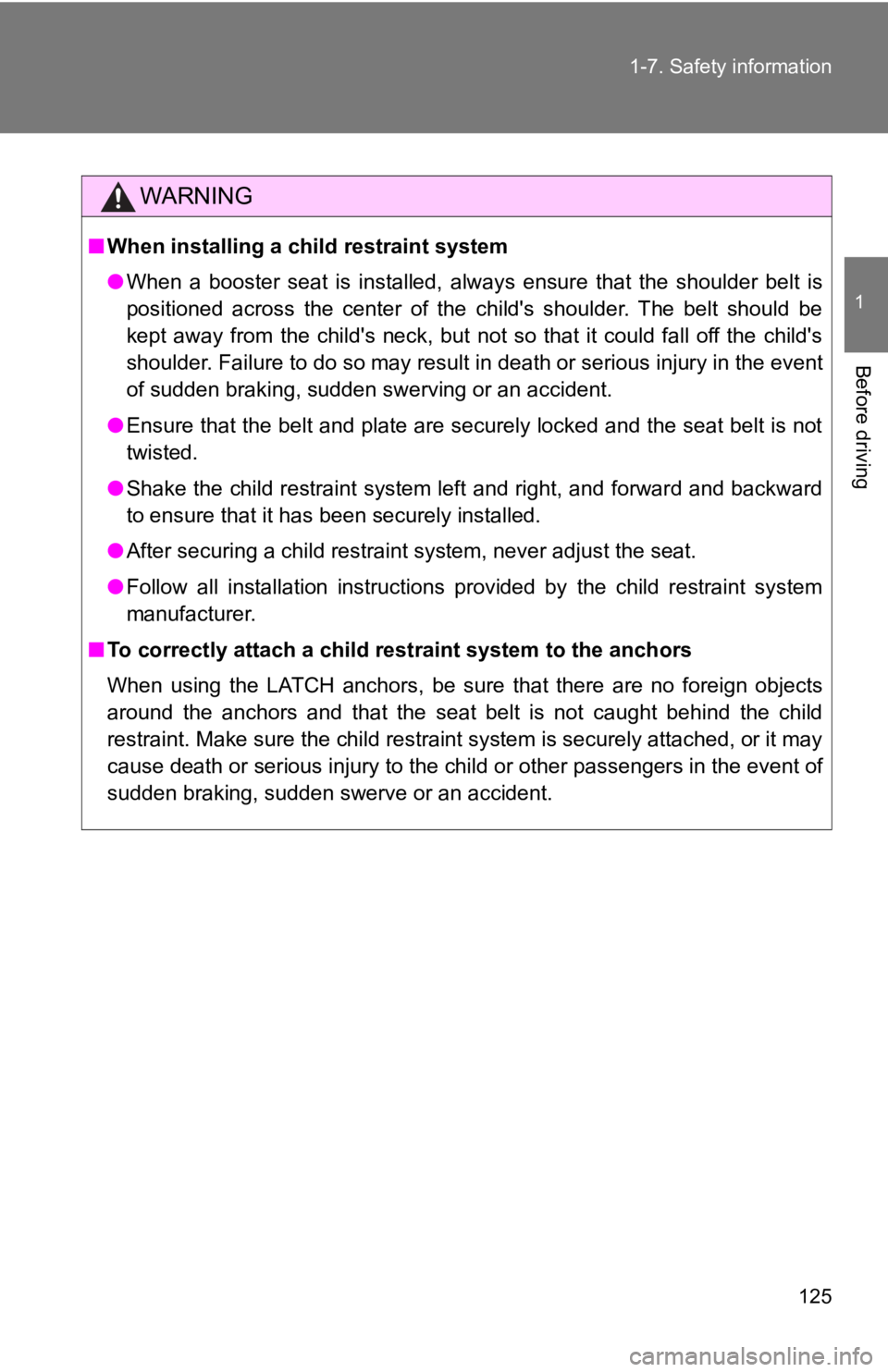
1251-7. Safety information
1
Before driving WARNING■ When installing a child restraint system
● When a booster seat is installed, always ensure that the shoulder belt is
positioned across the center of the child's shoulder. The belt should be
kept away from the child's neck, but not so that it could fall off the child's
shoulder. Failure to do so may result in death or serious injury in the event
of sudden braking, sudden swerving or an accident.
● Ensure that the belt and plate are securely locked and the seat belt is not
twisted.
● Shake the child restraint system left and right, and forward and backward
to ensure that it has been securely installed.
● After securing a child restraint system, never adjust the seat.
● Follow all installation instructions provided by the child restraint system
manufacturer.
■ To correctly attach a child restraint system to the anchors
When using the LATCH anchors, be sure that there are no foreign objects
around the anchors and that the seat belt is not caught behind the child
restraint. Make sure the child restraint system is securely attached, or it may
cause death or serious injury to the child or other passengers in the event of
sudden braking, sudden swerve or an accident.
Page 126 of 428

1261-7. Safety information
Page 127 of 428
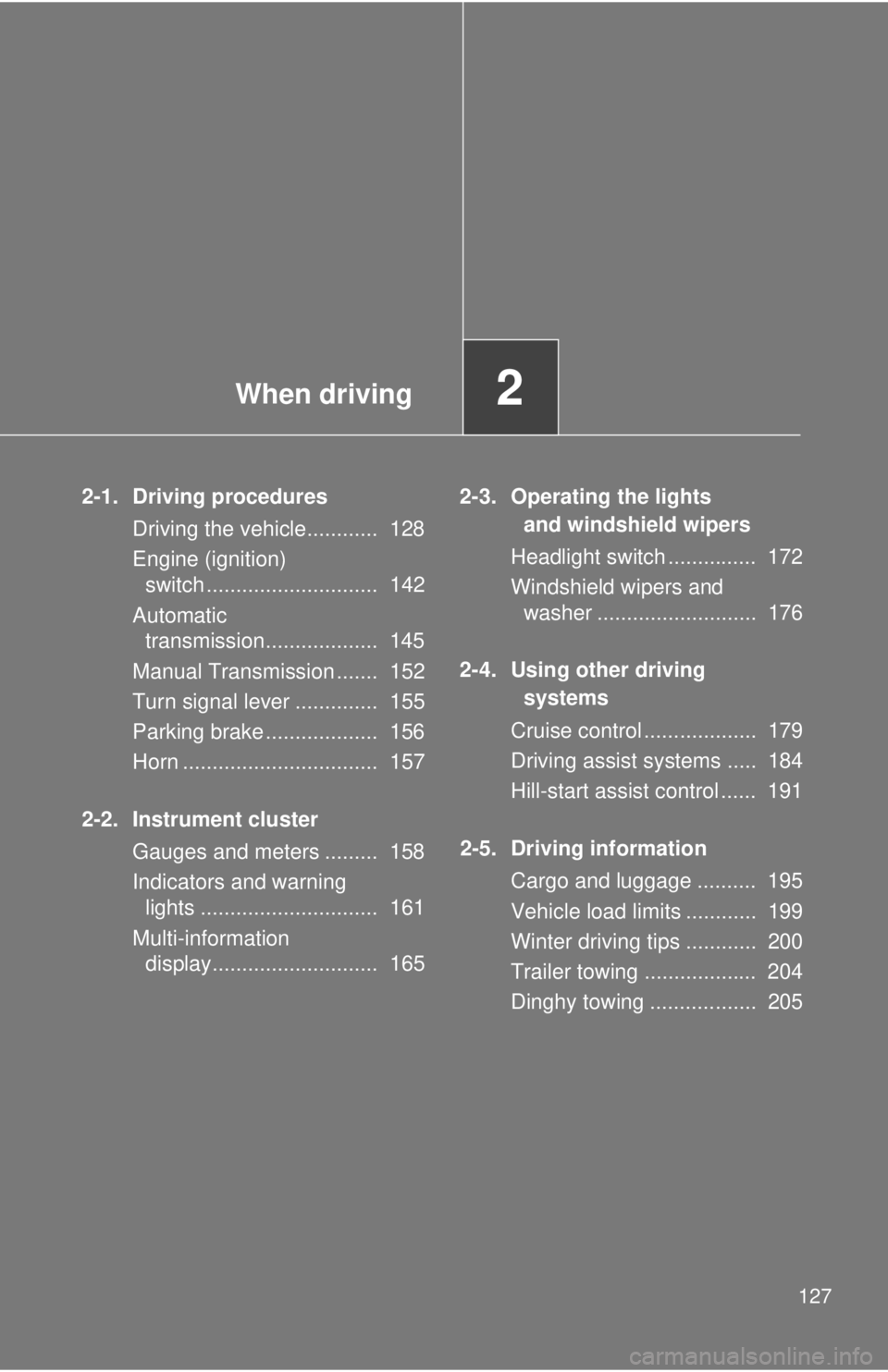
When driving
2
1272-1. Driving procedures
Driving the vehicle............ 128
Engine (ignition)
switch ............................. 142
Automatic
transmission................... 145
Manual Transmission ....... 152
Turn signal lever .............. 155
Parking brake ................... 156
Horn ................................. 157
2-2. Instrument cluster
Gauges and meters ......... 158
Indicators and warning
lights .............................. 161
Multi-information
display............................ 165 2-3. Operating the lights
and windshield wipers
Headlight switch ............... 172
Windshield wipers and
washer ........................... 176
2-4. Using other driving
systems
Cruise control ................... 179
Driving assist systems ..... 184
Hill-start assist control ...... 191
2-5. Driving information
Cargo and luggage .......... 195
Vehicle load limits ............ 199
Winter driving tips ............ 200
Trailer towing ................... 204
Dinghy towing .................. 205
Page 128 of 428
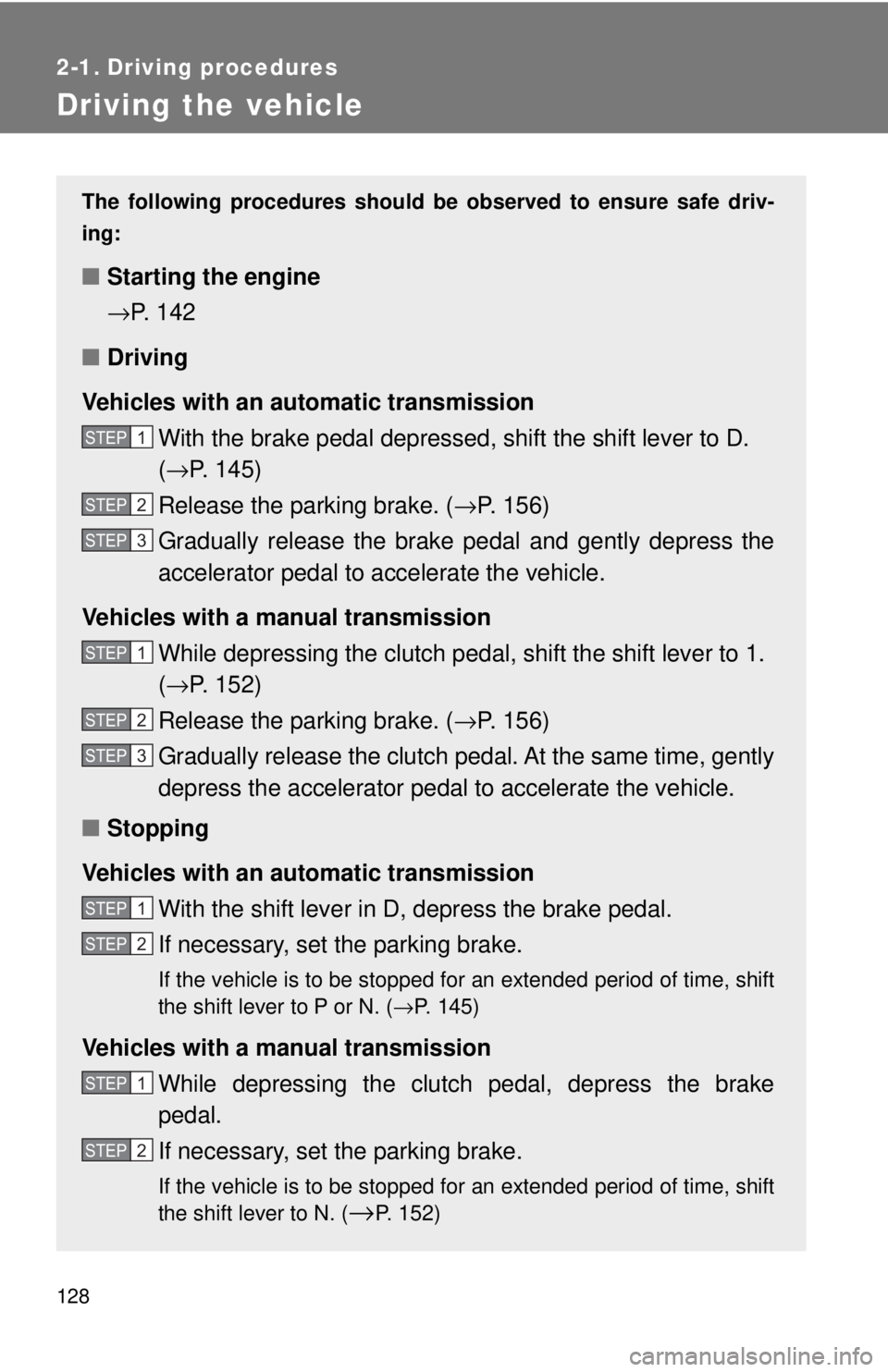
1282-1. Driving procedures
Driving the vehicle The following procedures should be observed to ensure safe driv-
ing:
■ Starting the engine
→ P. 142
■ Driving
Vehicles with an au tomatic transmission
With the brake pedal depressed, shift the shift lever to D.
( → P. 145)
Release the parking brake. ( → P. 156)
Gradually release the brake pedal and gently depress the
accelerator pedal to accelerate the vehicle.
Vehicles with a manual transmission
While depressing the clutch pedal , shift the shift lever to 1.
( → P. 152)
Release the parking brake. ( → P. 156)
Gradually release the clutch pedal. At the same time, gently
depress the accelerator pedal to accelerate the vehicle.
■ Stopping
Vehicles with an au tomatic transmission
With the shift lever in D, depress the brake pedal.
If necessary, set the parking brake. If the vehicle is to be stopped for an extended period of time, shift
the shift lever to P or N. ( → P. 145)
Vehicles with a manual transmission
While depressing the clutch pedal, depress the brake
pedal.
If necessary, set the parking brake.
If the vehicle is to be stopped for an extended period of time, shift
the shift lever to N. (
→ P. 152) STEP 1
STEP 2
STEP 3
STEP 1
STEP 2
STEP 3
STEP 1
STEP 2
STEP 1
STEP 2
Page 129 of 428
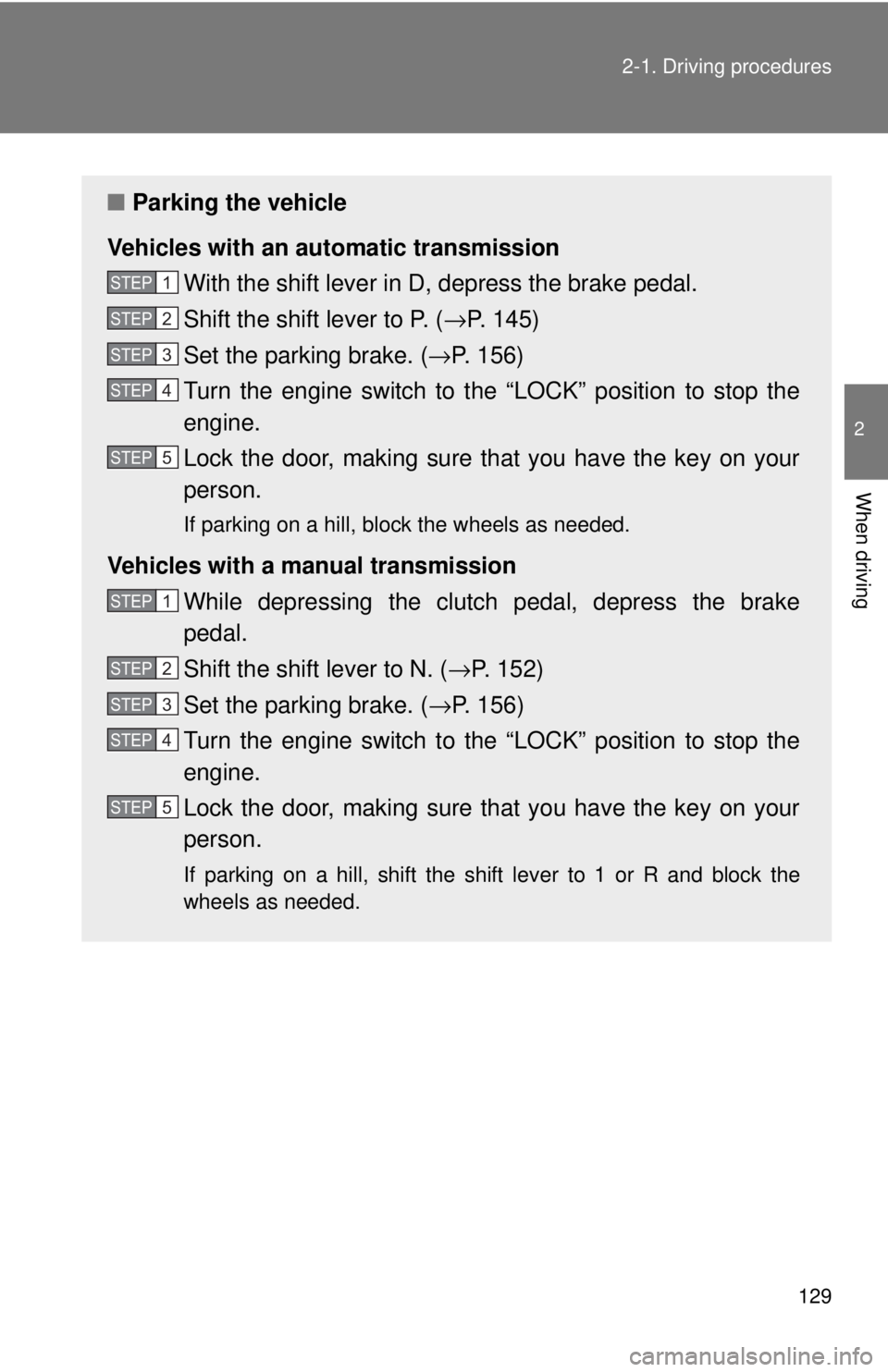
1292-1. Driving procedures
2
When driving ■ Parking the vehicle
Vehicles with an au tomatic transmission
With the shift lever in D, depress the brake pedal.
Shift the shift lever to P. ( → P. 145)
Set the parking brake. ( → P. 156)
Turn the engine switch to the “LOCK” position to stop the
engine.
Lock the door, making sure that you have the key on your
person. If parking on a hill, block the wheels as needed.
Vehicles with a manual transmission
While depressing the clutch pedal, depress the brake
pedal.
Shift the shift lever to N. ( → P. 152)
Set the parking brake. ( → P. 156)
Turn the engine switch to the “LOCK” position to stop the
engine.
Lock the door, making sure that you have the key on your
person. If parking on a hill, shift the shift lever to 1 or R and block the
wheels as needed.STEP 1
STEP 2
STEP 3
STEP 4
STEP 5
STEP 1
STEP 2
STEP 3
STEP 4
STEP 5
Page 130 of 428
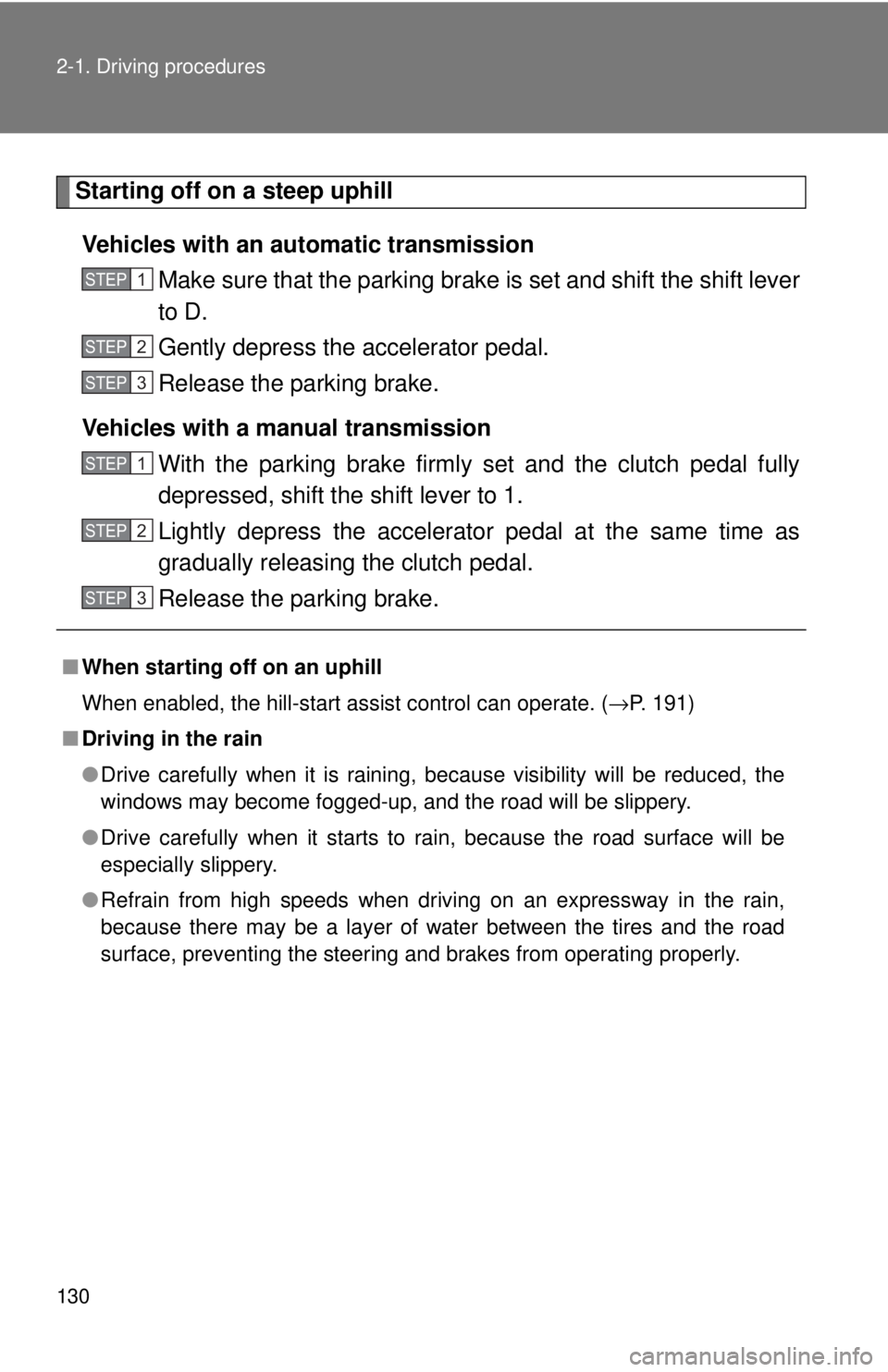
1302-1. Driving procedures
Starting off on a steep uphill
Vehicles with an au tomatic transmission
Make sure that the parking brake is set and shift the shift lever
to D.
Gently depress the accelerator pedal.
Release the parking brake.
Vehicles with a manual transmission
With the parking brake firmly set and the clutch pedal fully
depressed, shift the shift lever to 1.
Lightly depress the accelerator pedal at the same time as
gradually releasing the clutch pedal.
Release the parking brake. ■ When starting off on an uphill
When enabled, the hill-start assist control can operate. ( → P. 191)
■ Driving in the rain
● Drive carefully when it is raining, because visibility will be reduced, the
windows may become fogged-up, and the road will be slippery.
● Drive carefully when it starts to rain, because the road surface will be
especially slippery.
● Refrain from high speeds when driving on an expressway in the rain,
because there may be a layer of water between the tires and the road
surface, preventing the steering and brakes from operating properly. STEP 1
STEP 2
STEP 3
STEP 1
STEP 2
STEP 3